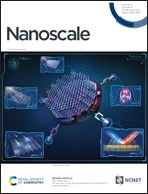Improvement in quantum yield by suppression of trions in room temperature synthesized CsPbBr3 perovskite quantum dots for backlight displays†
Abstract
Surface defects and synthesis methods play important roles in the photoluminescence quantum yield (PLQY), stability, and the device performance of lead halide perovskite quantum dots (PQDs). In this study, we report a quadruple-ligand (tri-n-octylphosphine, didodecyldimethylammonium bromide, tetraoctylammonium bromide, and oleic acid) assisted room-temperature method for synthesizing CsPbBr3 QDs (RT-CsPbBr3) with an absolute PLQY of 83%. X-ray photoelectron spectroscopy confirms the high completeness of the Pb–Br octahedron through the absence of lead ions and presence of more bromide ions on the surface of RT-CsPbBr3 QDs. The exciton dynamics of RT-CsPbBr3 QDs is studied by using femtosecond transient absorption, time-resolved PL, and single-dot spectroscopy, which provide strong evidence of the suppression of trion formation compared with the hot injection-synthesized CsPbBr3 (HI-CsPbBr3) QDs. The white light-emitting diode (LED) fabricated with RT-CsPbBr3 PQDs and a K2SiF6:Mn4+ phosphor for backlight applications achieved a wide color gamut of 124% of the National Television System Committee (NTSC) standard.



 Please wait while we load your content...
Please wait while we load your content...
